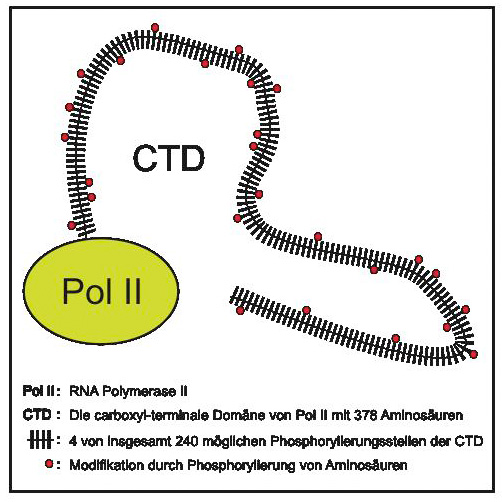Exact pol(e) position – precisely where the polymerase is changed

Source: Helmholtz Zentrum München
The contents in our genetic information are actually silent (meaning inactive) and first have to be made to “speak”. Like the read head in a tape recorder, RNA polymerase II, Pol II for short, runs over the DNA (tape) and transcribes the genetic and epigenetic information into RNA. In order to keep the enzyme from working randomly, however, it is dynamically modified at many different points in order to control its activity depending on the situation.
“Phosphorylation makes it possible to influence the activity of the enzyme at 240 different sites,” explains Prof. Dirk Eick, the study's last author and head of the Research Unit Molecular Epigenetics at Helmholtz Zentrum München. Together with colleagues from the Biomedical Center and Gene Center of the Ludwig-Maximilians-Universität München and the Max Planck Institute for Biophysical Chemistry in Göttingen, Germany, he and his team have developed a method for simultaneously examining all 240 sites in Pol II.
“The trick is a combination of genetic and mass spectrometric* methods,” reveals first author Dr. Roland Schüller. “By producing genetically modified variants of the regions in question, we can examine each individual phosphorylation site with a mass spectrometer.” This allows the researchers to determine exactly how and precisely where certain enzymes that influence phosphorylation act. The scientists also successfully compared the Pol II modification patterns in humans and in yeast.
“The regulation of the transcription of genes by Pol II is an elementary process in life and gene regulation deviations are the basis for many human disorders,” study leader Eick explains the work’s background. “Research into the phosphorylation pattern at certain times during the transcription cycle is therefore necessary in order to be able to gain an understanding of the underlying mechanisms of gene regulation at the transcription level sometime in the future.”
Further information
Background
* Mass spectrometry is a procedure that makes it possible to determine the mass of tiny molecules. This is done by transferring the substance to be examined into the gas phase and then electrically charging it. As a result of this charge, the molecules (or smaller fragments) can be accelerated through an electric field. The arrival of the molecules at the end of this field is then measured. Each molecule has its own flight duration that depends on the mass and that allows the substances to be sorted.
Original publication:
Schüller, R. et al. (2015). Heptad-specific Phosphorylation of RNA Polymerase II CTD, Molecular Cell
DOI: 10.1016/j.molcel.2015.12.003
http://www.cell.com/molecular-cell/abstract/S1097-2765%2815%2900937-5
The Helmholtz Zentrum München, the German Research Center for Environmental Health, pursues the goal of developing personalized medical approaches to the prevention and therapy of major common diseases such as diabetes and lung disease. To achieve this, it investigates the interaction of genetics, environmental factors and lifestyle. The Helmholtz Zentrum München has about 2,300 staff members and is headquartered in Neuherberg in the north of Munich. It is a member of the Helmholtz Association, a community of 18 scientific-technical and medical-biological research centers with a total of about 37,000 staff members. The Helmholtz Zentrum München is a partner in the German Center for Diabetes Research.
As one of Europe's leading research universities, LMU Munich is committed to the highest international standards of excellence in research and teaching. Building on its 500-year-tradition of scholarship, LMU covers a broad spectrum of disciplines, ranging from the humanities and cultural studies through law, economics and social studies to medicine and the sciences. 15 percent of LMU‘s 50,000 students come from abroad, originating from 130 countries worldwide. The know-how and creativity of LMU's academics form the foundation of the University's outstanding research record. This is also reflected in LMU‘s designation of as a “university of excellence” in the context of the Excellence Initiative, a nationwide competition to promote top-level university research.
Contact for the media:
Department of Communication, Helmholtz Zentrum München – German Research Center for Environmental Health (GmbH), Ingolstädter Landstr. 1, 85764 Neuherberg – Tel. +49 89 3187 2238 – Fax: +49 89 3187 3324 – E-mail: presse@helmholtz-muenchen.de
Scientific contact at Helmholtz Zentrum München:
Prof. Dr. Dirk Eick, Helmholtz Zentrum München – German Research Center for Environmental Health (GmbH), Research Unit Molecular Epigenetics, Marchioninistraße 25, 81377 München – Tel. +49 89 3187-1512 – E-mail: eick@helmholtz-muenchen.de
Media Contact
All latest news from the category: Life Sciences and Chemistry
Articles and reports from the Life Sciences and chemistry area deal with applied and basic research into modern biology, chemistry and human medicine.
Valuable information can be found on a range of life sciences fields including bacteriology, biochemistry, bionics, bioinformatics, biophysics, biotechnology, genetics, geobotany, human biology, marine biology, microbiology, molecular biology, cellular biology, zoology, bioinorganic chemistry, microchemistry and environmental chemistry.
Newest articles

First-of-its-kind study uses remote sensing to monitor plastic debris in rivers and lakes
Remote sensing creates a cost-effective solution to monitoring plastic pollution. A first-of-its-kind study from researchers at the University of Minnesota Twin Cities shows how remote sensing can help monitor and…

Laser-based artificial neuron mimics nerve cell functions at lightning speed
With a processing speed a billion times faster than nature, chip-based laser neuron could help advance AI tasks such as pattern recognition and sequence prediction. Researchers have developed a laser-based…

Optimising the processing of plastic waste
Just one look in the yellow bin reveals a colourful jumble of different types of plastic. However, the purer and more uniform plastic waste is, the easier it is to…



